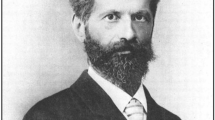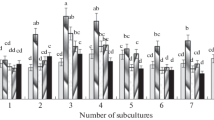Summary
In regeneration the totality of processes which take place during the time interval between the isolation of cells and the first nuclear divisions is called embryonization. The influence of pretreatment of the intact plant on the length of this time interval (“Embryonalisierungszeit”) was investigated. Regeneration was induced by isolating tissue fragments from the wing of Riella (Fig. 1).
In tissues isolated from certain regions of plants grown in the dark the time for embryonization is always shorter than in those isolated from corresponding regions of plants grown under light-dark-cycles (Fig. 2).
It is known that isolated tissue from plants grown under light-dark-cycles needs the more time for embryonization the older it is, i.e. the greater the distance between the tissue and the meristem is. An apical region of the wing was marked by a small incision into the margin of the wing (Fig. 3). After 12 days the increase in distance between the mark and the meristem was the same in plants grown in light-dark-cycles as it was in plants grown in the dark (Table 1). However, when the plants were grown in the dark and the tissue directly below this incision was isolated, the time for embryonization did not increase with increasing distance between the mark and the meristem (Table 2). This means that in the dark the cells do not age with respect to embryonization. However, the darkness does not have a generally retarding influence on ageing, since the cells at the base of the plant die in the dark as well as in the light-dark-cycle.
Zusammenfassung
Bei der Regeneration wird die Gesamtheit der Vorgänge, die in der Zeit von der Auslösung der Regeneration bis zum Einsetzen der Kernteilungen in den regenerierenden Zellen ablaufen, als Embryonalisierung bezeichnet. Der Einfluß der Vorbehandlung der ganzen Pflanzen auf die Embryonalisierungszeit isolierter Gewebestücke (Fragmente) aus dem Thallus von Riella wurde untersucht.
Die Embryonalisierungszeit der Fragmente aus Pflanzen mit mehrtägigen Dunkelbehandlungen vor Auslösung der Regeneration ist stets kürzer als die der Fragmente aus den entsprechenden Zonen von gleichalten Pflanzen aus dem Licht-Dunkel-Wechsel.
Es war bekannt, daß das Gewebe der Pflanzen aus dem Licht-Dunkel-Wechsel mit zunehmendem Abstand vom Meristem und zunehmendem Alter zunehmend längere Embryonalisierungszeiten benötigt. Bei den Pflanzen im Dunkeln altert dagegen das Gewebe trotz zunehmenden Abstands vom Meristem in bezug auf die Embryonalisierung nicht, die Embryonalisierungszeit bleibt konstant. Jedoch hat die Dunkelbehandlung nicht einen allgemein verzögernden Einfluß auf das Altern, denn an der Basis der Pflanzen stirbt im Dunkeln eine mindestens so breite Region ab wie im Licht-Dunkel-Wechsel.
Similar content being viewed by others
Literatur
Goebel, K.: Archegoniatenstudien. XI. Weitere Untersuchungen über Keimung und Regeneration bei Riella und Sphaerocarpus. Flora (Jena) 97, 192–215 (1907).
Karsten, I.: Der Zeitpunkt der Kernteilungen in regenerierenden Zellen von Riella helicophylla nach einer vorangegangenen Dunkelperiode. Naturwissenschaften 50, 50–51 (1963).
—: Über den Einfluß des Lichts aud die Embryonalisierung differenzierter Zellen von Riella helicophylla. Z. Pflanzenphysiol. 56, 305–324 (1967).
Lehmann, H.: Über die Regenerationsleistung isolierter Einzelzellen und kleiner Zellverbände von Riella helicophylla. Planta (Berl.) 71, 240–256 (1966).
Mather, K.: Statistische Analysen in der Biologie. Wien: Springer 1955.
Romeis, B.: Mikroskopische Technik. München: Leibniz 1948.
Serra, J. A., et A. Q. Lopes: Données pour une cytophysiologie du nucléole. I. L'activité nucléolaire pendant la croissance de l'oocyte chez des Helicidae. Port. Acta biol. 1, 51–94 (1945).
Stange, L.: Untersuchungen über die Beeinflussung von Regenerationsvorgängen bei Riella. Ber. dtsch. bot. Ges. 68, 33–34 (1955).
—: Untersuchungen über Umstimmungs- und Differenzierungsvorgänge in regenerierenden Zellen des Lebermooses Riella. Z. Bot. 45, 197–244 (1957).
—: Die Abhängigkeit der Regenerationsvorgänge bei Riella von der Dauer und dem Zeitpunkt der Photosynthese. Z. Bot. 48, 143–152 (1960).
—: Regeneration in lower plants. Advanc. Morphogenes. 4, 111–153 (1964).
—: Zelldifferenzierung und Embryonalisierung bei dem Lebermoos Riella. Ber. dtsch. bot. Ges. 78, 411–417 (1965).
Stenram, N.: The specifity of the gallocyanin-chromalaun stain for nucleic acids as studied by the ribonuclease technique. Exp. Cell Res. 4, 383–389 (1953).
Author information
Authors and Affiliations
Rights and permissions
About this article
Cite this article
Karsten, I. Über den Einfluß der Vorbehandlung der ganzen Pflanzen auf die Embryonalisierung differenzierter Zellen von Riella helicophylla . Planta 76, 1–10 (1967). https://doi.org/10.1007/BF00387417
Received:
Issue Date:
DOI: https://doi.org/10.1007/BF00387417




